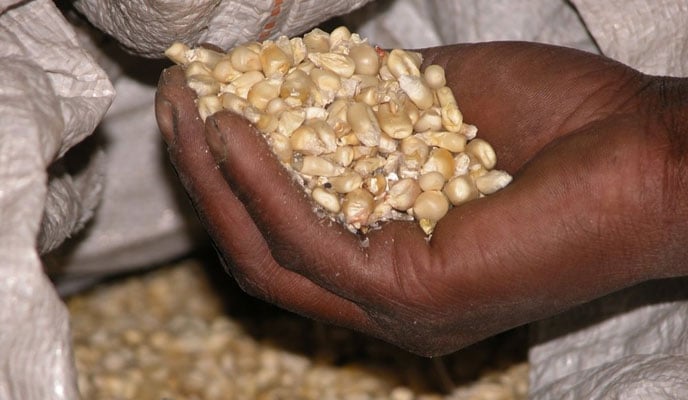
Farmers can now test their maize and other cereals for aflatoxin before taking the produce to market. PHOTO/FILE
|Aflatoxin testing kit here for farmers
What you need to know:
- The machine has a variety of treatment programmes according to the level of contamination, it also kills mites, insects and bacteria.
Maize was first introduced in Uganda in 1861 and by 1900 it had become a major crop, grown for both commercial and home consumption needs.
Hundreds of years later, the cereal is one of the major staple foods in Uganda, giving more than 40 percent of Uganda’s daily calorie consumption through different meals.
ALSO READ: Aflatoxins are containable
According to Crop Life International, an association based in Belgium which promotes agricultural technologies such as pesticides and plant biotechnology, more than two million Ugandans depend on maize as their main source of income.
2019 saw Uganda produce up to two and a half million tonnes of maize before Covid-19 pandemic affected the numbers.
Aflatoxins
Maize farmers were even dealt a bigger blow when in March last year, Kenya banned the importation of maize from Uganda after discovering high levels of aflatoxins.
ALSO READ: Key steps in curbing aflatoxin in maize
It was a safety measure as maize with aflatoxins is deemed dangerous for human and animal consumption.
This development frustrated farmers who were stuck with the maize. Uganda has in the process lost more than $38m (Shs134b) as a result of its inability to sell maize owing to aflatoxins.
The Ugandan government is facing a significant budgetary load. Post-harvest grain handling activities are of poor quality, and many grain handlers are unaware of aflatoxins.
ALSO READ: Managing aflatoxins in groundnuts
Aflatoxins is a type of mycotoxin produced by Aspergillus species of fungi, such as A. flavus and A. parasiticus. The umbrella term aflatoxin refers to four different types of mycotoxins produced, which are B1, B2, G1, and G2. Aflatoxin B1, the most toxic, is a potent carcinogen and has been directly correlated to adverse health effects, such as liver cancer in many animal species.
Aflatoxins are largely associated with commodities produced in the tropics and subtropics, such as cotton, peanuts, spices, pistachios, and maize.
Ray of hope
There seems to be light at the end of the tunnel with a solution found. PELA Commodities, a Ugandan company based in Arapai, Soroti District that buys, processes, packages and markets agricultural grain products is installing Uganda’s first aflatoxin removal machine.
ALSO READ: Aflatoxins can cause liver cancer
The mechanism is built by Danish Biochemical Company, Eye-Grain, and Perry Engineering who are the official distributors of the toxi-scrub system designed for large scale detoxification of contaminated commodities.
This will help kill aflatoxins and related toxins from maize and other grain.
The machine has a variety of treatment programmes according to the level of contamination, it also kill mites, insects and bacteria.
The plant is a project that will take six weeks to assemble before being tested and commissioned in the near future.
A Danish contingent arrived into the country and immediately set off to Soroti to get working.
“Uganda’s grain handlers have had a long-standing aflatoxin problem, but this is a step in the right direction to help enhance our yields and output. It will turn harmful maize or grain that cannot be exported or sold to reputable processors into a high-value product. We have already trained our team members on aflatoxin testing and they are ready to start operating the machine,” says Isaiah Langa the PELA Commodities general manager.
ALSO READ: Aflatoxins hurt farmers’ earnings
Upon commission, the facility will be opened to the public whereby farmers’ maize will be treated by washing, cleaning and removal of aflatoxins at a fee. Grains such as wheat, corn, barley, rice and oats can also be treated while list of nuts includes peanut, soy bean, walnuts, hazelnuts, pistacio and coconut are all treatable.
How do aflatoxins come about?
• Too little rain at the cultivation stage weakens the crops’ natural defences against fungal infection, this leaves crops vulnerable.
• Excess rain during harvest makes it difficult to dry the crops before storage. This too can lead to increased chances of aflatoxin infection.
• Some farmers pack their maize before it can fully dry in search of more weight to gain more money. This practice creates room for aflatoxins which can be detected when moulds are seen.
• Poor plant nutrition too is a probable cause. It weakens crops and makes then prone to being attacked by fungus. The fungus can continue to grow on crops if not properly stored and exposed to moisture, or if not well dried.
How the machine works
The design of the processing line is made as an all in one design from delivery of raw material in the incoming pit, until packaging. The material handling is done in a closed and airtight system. This is important because the ozone must not leak.
ALSO READ: About aflatoxins
The client may choose their own supplier of packaging machine, but due to the nature of ozone, it is recommended that only materials resistant to ozone should be used. After the process, the material can be packaged in different quantities according to the farmers’ specifications.
Key facts
Aflatoxins is a type of mycotoxin produced by Aspergillus species of fungi, such as A. flavus and A. parasiticus.
The umbrella term aflatoxin refers to four different types of mycotoxins produced, which are B1, B2, G1, and G2. Aflatoxin B1, the most toxic, is a potent carcinogen and has been directly correlated to adverse health effects, such as liver cancer in many animal species.




